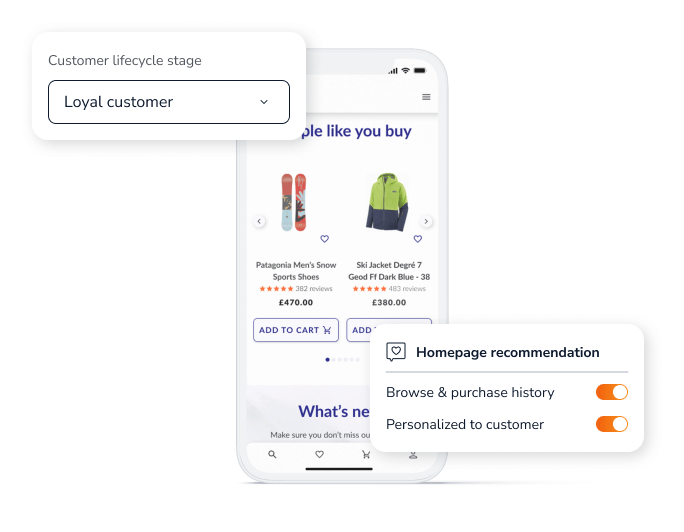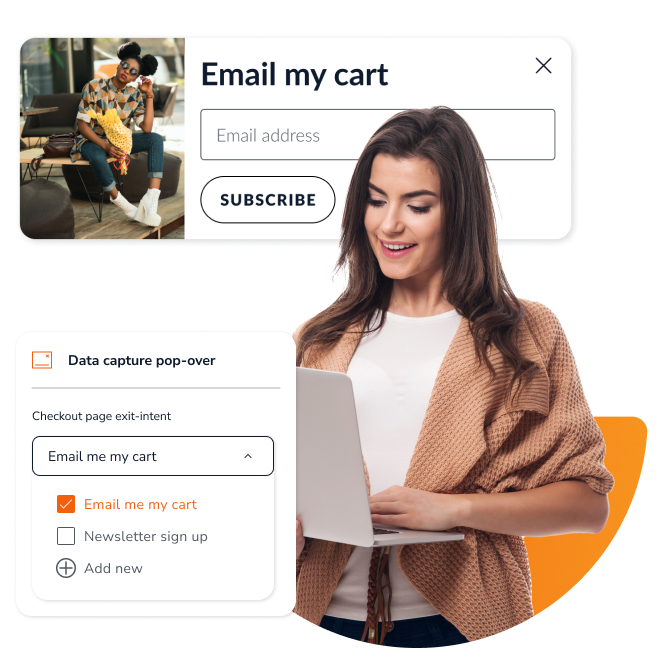Did you know that 89% of digital businesses are investing in personalization tools? It’s not surprising, considering the immense value that website personalization brings to the table. Tailoring your website content to each visitor’s preferences and needs can lead to higher engagement, improved conversion rates, and ultimately, a more satisfied and loyal customer base.
In this blog, we explore the various types of website personalization that you can use to enhance your customer’s online experiences. From dynamic content to personalized recommendations, we’ll walk you through the strategies and techniques you can implement to take your website personalization to the next level.
Three types of website personalization
There are three primary ways to personalize your website and deliver a tailored experience to each visitor:
1. Dynamic content
Personalizing your website is key to engaging your customers, and dynamic content is a powerful tool to achieve just that. With dynamic content, you can display tailored content to users based on their browsing history, interests, and demographics. This real-time personalization technique can offer different products, services, and offers to users and returning customers alike.
For example, if a customer visits your sports equipment website during a holiday, they may require some last-minute gear. You can showcase dynamic content that reflects the current weather at the shopper’s location when they are browsing, offering them tailored product suggestions, such as winter boots if it’s snowing.
On the other hand, when a returning customer visits, you can show them a banner highlighting their favorite brand’s latest running shoes. Dynamic content allows you to display personalized offers, product suggestions or smart countdown timers that create a sense of urgency and excitement.
Here’s a snapshot of the benefits dynamic content brings to your website:
- Increased engagement: Showcasing what visitors are most likely interested in keeps them engaged and exploring your site.
- Personalized offers: Target specific promotions and discounts based on demographics and preferences.
- Real-time relevance: Leverage weather data, time of day, and browsing history to deliver contextually relevant content.
2. Product recommendations
Product recommendations powered by AI are a game-changer for website personalization. They leverage user data like browsing history, purchase behavior, and even demographics to suggest relevant products that keep customers engaged and drive sales.
Picture a shopper looking at a pair of sneakers. AI-driven product recommendations can assist customers in finding the ideal fit by suggesting similar styles based on features, materials, or brands. Additionally, if customers want to complete their look, you can suggest related products like matching socks and laces to create a cohesive style.
Personalized recommendations make shopping smarter, not harder, helping you find the perfect fit and leave feeling confident about your purchase.
Here’s how personalized recommendations can elevate your customer’s experience:
- Boost conversions: Recommend complementary items and frequently bought together bundles to increase order value.
- Fuel discovery: Surface new products that visitors might not have considered but are likely interested in based on their browsing history.
- Personalized shopping experience: Help customers find the perfect fit by suggesting similar items or products “people like you buy.”

3. Overlays
Overlays, also known as popovers, are like friendly salespeople on your website, strategically placed to capture user attention and drive conversions. These dynamic messages adapt to individual users based on their behavior, preferences, and past interactions, creating a personalized touch that resonates.
For instance, you may have a first-time visitor arriving on your retail site. A well-timed popover greets them with a warm welcome and a discount code, enticing them to join your email list.
When a returning customer visits your website, they are greeted with a helpful popover message showing products that are “still in their basket” or encouraging them to “pick up where they left off.” These popovers enhance the shopping experience, making it even smoother and more enjoyable.
Here’s how you can use targeted overlays to personalize online experiences and drive results:
- Capture high-value leads: Convert new visitors into loyal customers by offering signup incentives tailored to their interests.
- Rescue abandoned carts: Win back potential sales with exit-intent popups featuring personalized product recommendations and messaging based on abandoned cart contents.
- Reignite interest with past visitors: Re-engage returning customers by reminding them of forgotten items or offering exclusive deals based on previous purchases.
- Boost order value: Increase average order value by displaying personalized product recommendations based on real-time browsing behavior.
- Gather valuable customer insights: Leverage targeted surveys within overlays to collect zero-party data and valuable customer feedback to further personalize the shopping experience.

Four successful ways to perform web personalization
Here are four successful ways to leverage text personalization and craft a journey that resonates with your audience:
1. Text personalization
Personalizing website text with the visitor’s name can create a more welcoming and human touch. This is especially effective in account areas or sign up pages.
For example, imagine a visitor named Sarah browsing a sporting goods website. Text personalization can take her browsing history into account. Instead of a generic homepage greeting, she might see a warm welcome like “welcome back, Sarah. Looking for that perfect running shoe?” This personalized approach acknowledges her past interests and gently guides her toward relevant products.
Further down the page, blog posts about “top running shoes for spring” or “training tips for beginners” might be displayed, catering directly to her needs. This level of personalization creates a sense of recognition and increases the likelihood of Sarah engaging with the website’s content.
2. Product personalization
Personalizing product recommendations can significantly boost sales. For example, if a visitor recently purchased a new camera, product personalization can use this information to display a curated selection of camera lenses and accessories on the homepage. This approach capitalizes on the visitor’s existing interest and makes it easier for them to discover complementary products they might need.
In addition, your website could dynamically offer personalized product bundles or discounts. For instance, a discount on a phone case and screen protector could be presented to someone who just viewed a new phone model.
By showcasing relevant products and offering enticing deals, product personalization increases the chances of visitors making additional purchases.
3. Image personalization
A visually appealing and engaging website is important to capture your audience’s attention. Image personalization plays a key role in enhancing this aspect.
Let’s take a travel website, for example. A visitor interested in urban destinations might be greeted with a captivating hero image of a bustling cityscape.
On the other hand, someone researching a relaxing getaway might see a serene beach scene. This approach tailors the visuals to the visitor’s preferences, creating a more engaging and relevant experience right from the start of their browsing journey.
Similarly, product images can be personalized to resonate with the visitor’s demographics. For instance, athletic apparel might be displayed on models engaged in workouts for visitors browsing that category. By using visuals that align with visitor interests, image personalization fosters a stronger connection with the brand.
4. Call-to-action (CTA) personalization
The CTA button is a crucial prompt for visitors to take a desired action. CTA personalization ensures the call to action resonates with each visitor.
For instance, a new visitor to a website might be more receptive to a CTA like “learn more” that provides additional information about the brand or its products. However, a returning customer familiar with the brand might be more likely to respond to a CTA like “buy now” that encourages them to complete a purchase.
Additionally, CTAs can be personalized with urgency triggers like “limited time offer” or “shop now and get free shipping” to motivate action, particularly for visitors who might be considering a purchase. By tailoring CTAs to the visitor’s journey stage, personalization increases the likelihood of them converting.
How to know what type of web personalization is right for your business
But with the range of web personalization options available, it can be challenging to determine which website personalization strategy to use. Here’s a detailed roadmap to guide you through the process:
1. Define your goals
The first step is to identify your key objectives. Ask yourself if you are aiming to:
- Increase email signups
- Reduce cart abandonment
- Boost average order value
- Improve customer satisfaction
Understanding your goals will help you prioritize the personalization techniques that best align with your desired outcomes.
2. Understand your audience
Take the time to gain insights into your ideal customers. What are their needs, preferences, and pain points? By gathering data through analytics and customer interactions, you can develop detailed buyer personas to better understand your audience segments.
3. Implement personalization techniques
After understanding your audience, start by prioritizing and experimenting with the different website personalization methods. Then you can see which one best aligns with your goals and target audience.
Remember to A/B test different personalization strategies to determine what resonates best with your audience and continuously optimize your approach.
4. Track and analyze
Continuously monitor your website analytics to assess the impact of your personalization efforts. Track key metrics such as conversion rates, bounce rates, and average order value to understand what’s working and where you can improve.
Remember, web personalization is an ongoing journey, not a one-time destination. As you gather data and learn from customer behavior, you can refine, test, and implement new techniques to continuously enhance the visitor experience and achieve your marketing objectives.
Conclusion
By utilizing these personalization techniques, you can meet the evolving needs of your audience. To succeed, define your goals, understand your audience, implement personalization strategies, and consistently track and analyze results. With time and optimization, you can create a personalized experience that keeps your customers engaged and loyal.






